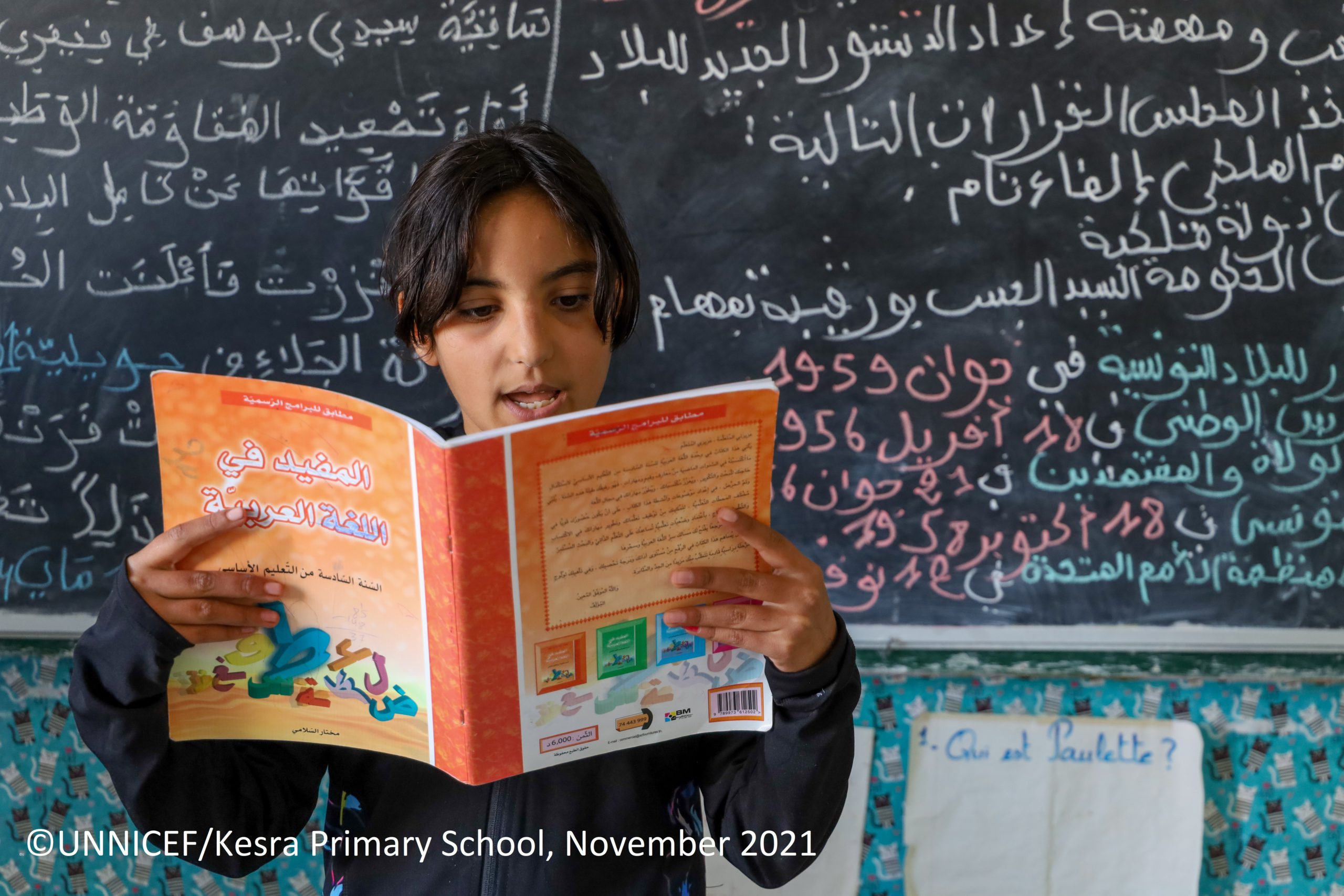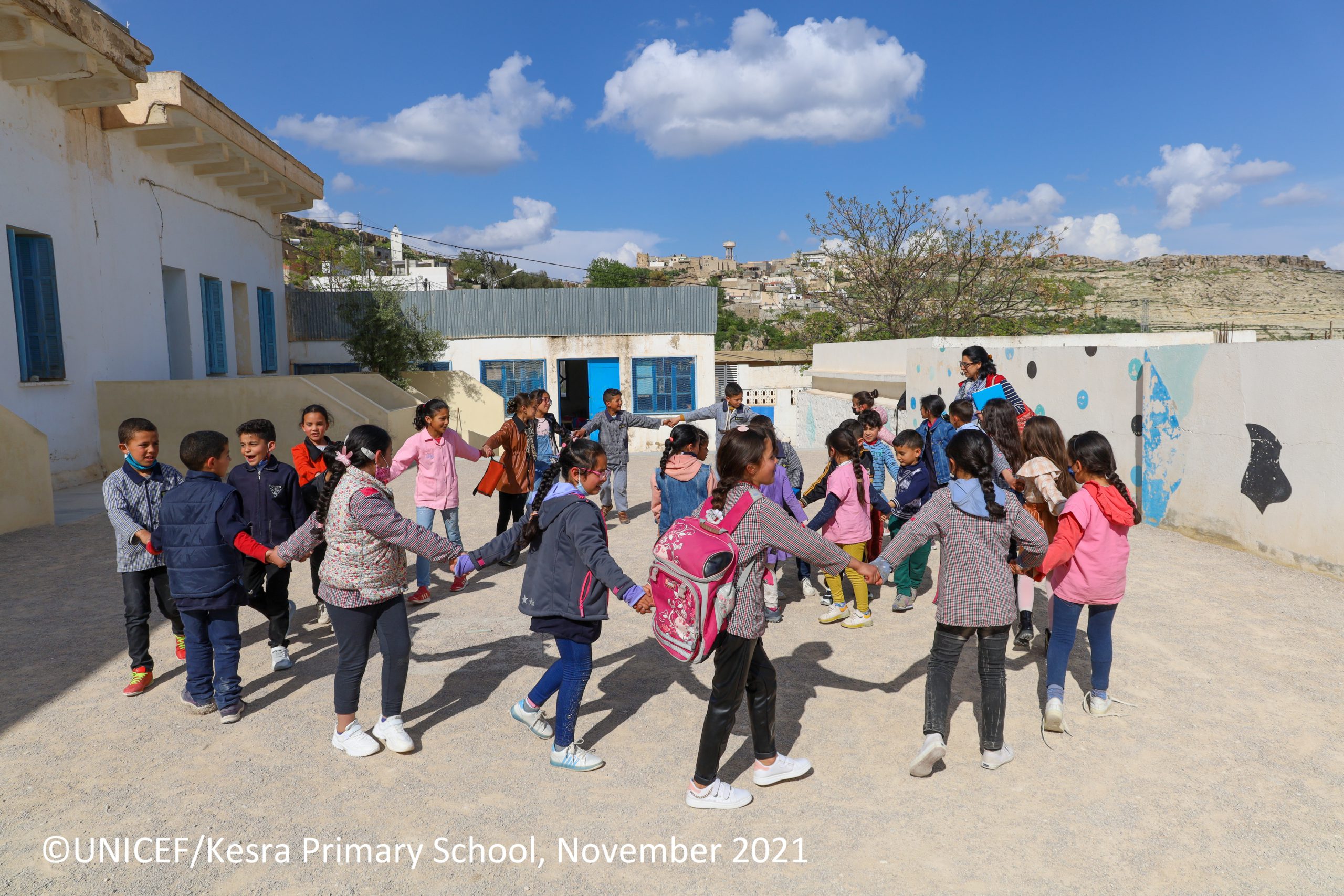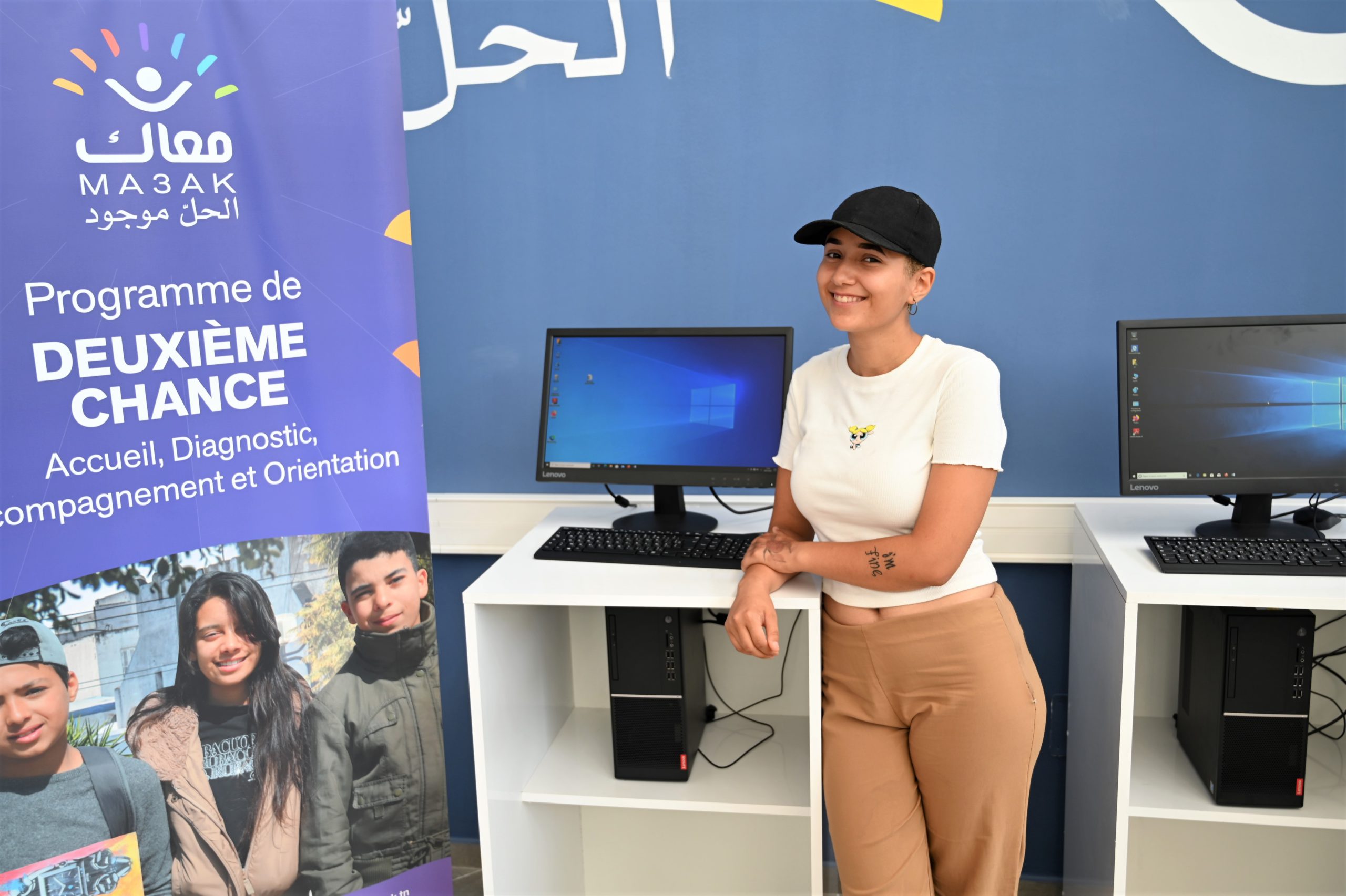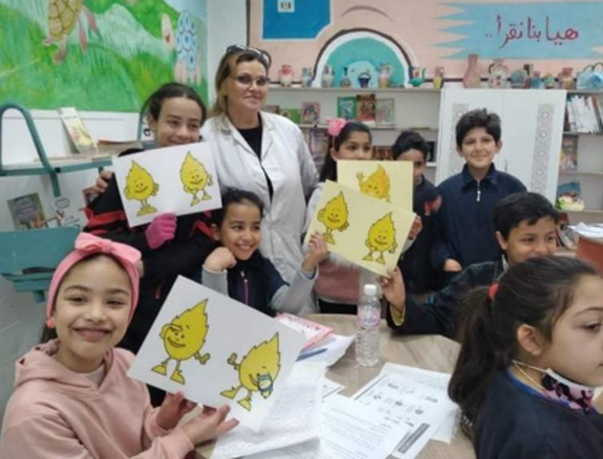From Tunisia, the host country of the 8th Tokyo International Conference on African Development (TICAD 8), Ms. Chieko Watanabe, the Education Officer of UNICEF Tunisia, contributed an article to EDU-Port Japan Website. We hope the article provides you with an opportunity to think about education for Tunisian children, that should ensure equitable quality education for all.
Background of Tunisian Education
Since its independence from France in 1956, Tunisia has put education as a national priority and has made significant efforts in the development of the education system by transforming the French model to the Tunisian model, based on the Arabic language. By 1970s, public institutions started teaching most subjects in Arabic, except certain subjects such as mathematics and science[1].

In 1990, the Tunisian government enacted a new education legislation which addresses that basic education[2] s compulsory and free of charge for all children aged 6 to 16 years. Since then, the enrolment rate has remarkably improved. According to the Multi Indicator Cluster Survey 6[3] (MICS 6), in 2018, the enrolment rate at the primary and lower secondary education levels were at 96.9% and 82% respectively.
In 2016, the Tunisian government initiated an ambitious reform in education and developed the education sector plan 2016-2020, focusing on the quality of education which includes the capacity building of educators, the improvement of learning outcomes, and the reduction of out-of-school and drop-out children etc. The progressive efforts have achieved universal primary education with gender parity, investing an average of about 6% of its Gross Domestic Product and over 15% of its national budget in education.
In spite of these efforts and progress, many challenges remain. As the MICS 6 shows, 33% of children aged 7 to 14 years do not achieve basic reading skills and 72% of children in the same age group do not achieve basic skills in mathematics. In the same survey, while 95% of children completed primary school, less than 50% completed upper secondary school. It also reveals a large disparity in children’s learning achievements by household incomes. Only 53% of children from the poorest households compared to 95% of children from the wealthiest households complete lower secondary school and only 24% of children from the poorest households compared to 80% of children from the wealthiest households complete upper secondary school.
UNICEF’s intervention in education
UNICEF has been supporting for decades the Ministry of Education (MoE), and in the context of the Sustainable Development Goals (SDGs), since 2017 UNICEF has been working with the MoE to address SDG 4 -quality of education- through a holistic approach, including support for curricula reform, the mainstreaming of life-skills in curricula and teaching practice, support for pre-service and in-service teacher training, support for the development of a national evaluation system and strengthening administration capacities at central and decentralized levels. Also, UNICEF has supported for the development of alternative learning opportunities for both adolescents who are at risk of dropping out and those who have already dropped out. The focus of the intervention on establishing prevention and remediation systems in collaboration with the relevant Ministries contributes to achieving SDG 16, which calls for the promotion of strong institutions.

Impact of the COVID-19 pandemic
Pre-COVID-19, it was estimated that 100,000 children dropped out of school over the past 10 years and that 50,000 children were at risk of dropping out. Although most of them have returned to school, about 30,000 children have remained without alternatives, or NEET (not in employment, education, or training) in the short period of the COVID-19 pandemic.
The outbreak of the COVID-19 pandemic has exacerbated the pre-existing learning crisis in Tunisia. Children were out of school for four months in the 2019-2020 school year due to school closures and children’s face-to-face teaching time was halved to facilitate physical distancing during the whole of the 2020-2021 school year. Although schools fully reopened in September 2021, the negative impact of the COVID-19 pandemic has led to the worst learning gap in recent times. According to the MoE’s estimates, almost 70,000 children dropped out of school during the 2020-2021 school year[4] mainly due to the negative impacts brought by the COVID-19 pandemic, putting these children at increased risk of violence, child labour, being in contact with the law, irregular migration, etc.
UNICEF’s support for reducing out of school adolescents and school drop-outs
Among UNICEF’s key education interventions in Tunisia, the support for out-of-school adolescents and those at risk of dropping out are two flagship programmes in which I am currently engaged.
Second Chance education programme
The Second Chance education programme was initiated in 2016 by the three Ministries of Education, Social Affairs, and Employment and Vocational Training targeting out-of-school adolescents aged between 12 and 18 years old. The programme consists of two components; 1) the “Ma3aK”[5] (the one stop desk) provides individual accompaniment and orientation guidance to each adolescent seeking assistance; 2) the “Intale9”[6] rovides customized educational life-skills-based courses for 6 to 9 months for adolescents who require more time to build their learning/professional project. Both courses aim at supporting adolescents to return to school, enroll in vocational training or, for those aged over 16 years, enter the job market depending on the needs and expectations of adolescents. Through UNICEF’s support, two Second Chance centres became operational in Tunis by the end of 2020. Up to date, 1,861 adolescents have benefited from the Ma3ak and Inatle9 courses offered in the centres, and around 926 adolescents have found positive placements, meaning that they either returned to school, joined vocational training programmes or found job placements (as of 7 June 2022).

©UNICEF/August 2021 – Beneficiary of the centre of Bab el Khadra, Tunis
The drop-out prevention model
In 2018, UNICEF started supporting the designing and piloting a four-dimensional school drop-out prevention model -M4D- in 9 pilot schools with high school dropout rates in six governorates[7]. Following the development of the M4D model, 4 modules[8] were introduced and tested in the pilot schools in order to help these schools reduce their drop-out rates through structural and education prevention and remediation measures. To date, 850 students at risk of dropping out have been successfully identified and supported through the early warning system developed by the programme, and 5,893 students have directly benefited from the experimentation of the programme. 231 educators have been trained on the 4 modules of the M4D model to facilitate effective implementation of the model in the pilot schools. The MoE plans to expand the M4D model to another 9 schools in the 2022-2023 school year. In addition, 4,992 students enhanced their life skills thanks to participation in life-skills based extra-curricular activities carried out in 25 schools in partnership with a national civil society organization.

©ENDA Inter-Arabe
Students in the library club at Echarkia primary school, Kasserine 2022
Conclusion
Tunisia, like other countries, has been hit hard by the COVID-19 negatively affecting years of country’s efforts, increasing the numbers of children and adolescents who face learning difficulties, have been at the risk of dropping out, and have dropped out; thus, widening further learning gap in the country.
In recent years, Tunisia stopped participating in international assessments such as Programme for International Student Assessment (PISA) and Trends in International Mathematics and Science Study (TIMSS), and the process of the development of a national assessment system has just been initiated. Besides the unavailability of updated data, the negative impact of the COVID-19 pandemic makes the current learning situation of children and the impacts of interventions in the education sector uncertain.
On July 1, this year, Tunisia has joined in the Global Partnership for Education[9]and will be engaged in its sector analysis and the development of a strategic plan. It could certainly provide an opportunity for the Tunisian government to reaffirm the significance of equity and quality in education over the coming years.
While new trends such as digital learning and life skills-based education have been emerging and large attention has been paid to those by national and international partners, it is equally essential and urgent that the Tunisian government assesses the current learning situation of children and takes necessary measures to enable all children, especially at the basic education cycle (primary school and lower secondary school), to acquire foundation skills, motivating and supporting them in realizing their full potential according to their wish and their aspirations. They are also underlined as key actions in the RAPID approach[10]that UNICEF with partners have recently launched to tackle the learning crisis and ensure a rapid recovery in education after the COVID-19 pandemic, calling for a global effort for urgent actions.
Note: The information of this document expresses my personal views and opinions and does not necessarily represent the views of any organization.
__________________
■Profile

Chieko WATANABE
Education Officer, UNICEF Tunisia
Formerly at lower secondary schools in Osaka, the Embassy of Japan in Uganda and Djibouti, Koei Research & Consulting Inc. and others.
[1] Source: national report “the higher education system in Tunisia”, Mediterranean Network of National Information Centres, June 2019, http://www.meric-net.eu/files/fileusers/275_Tunisia_National%20Report%20template_MERIC-Net.pdf
[2] Basic education is split up into 2 stages: primary school, which lasts 6 years, and lower secondary school, which lasts for 3 years.
[3] The MICS 6 was launched in 2018 by the National Institute for Statistics through the support of UNICEF. The purpose of the survey is to examine the situation of children and women in Tunisia with a total of 183 indicators, which is conducted on average every 5 years. For the MICS 6, a total of 11,225 households were surveyed and the results were published in 2019.
[4] Source : article “Ministre de l’Education : 69 mille élèves ont abandonné l’école l’année dernière”, Tunisie Numérique, September 2021, https://bit.ly/3ixWJHq/
[5] “Ma3ak” means “with you” in Arabic.
[6] “Intale9” means “Go ahead” in Arabic.
[7] Ariana, Bizerte, Gabès, Kebili, Sfax and Siliana
[8] The M4D model is composed of following 4 modules; 1. An early warning system identifying students at risk of dropping out; 2. Learning support/tutoring; 3. Remedial education; 4. Extra-curricular activities
[9] Global Partnership for Education: https://www.globalpartnership.org/
[10] The RAPID approach calls on governments to take five key actions; 1. Reach and retain every child in school; 2. Assess learning levels; 3. Prioritize teaching the fundamentals; 4. Increase catch-up learning progress beyond what was lost; 5. Develop psychosocial health and well-being so very child is ready to learn







